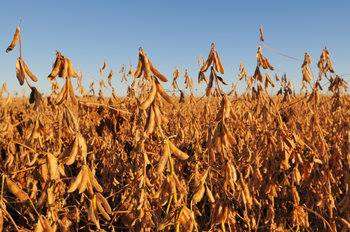By: The OMAFRA Field Crop Team

Photo credit: Jason Titzer/iStock/Getty Images Plus
Soybeans: Harvest began the previous week in parts of western and central Ontario. Yield reports have been variable ranging from single digit to upper 60 bu/ac. Low yield reports, not surprisingly, appear to correspond closely with the precipitation received throughout the season. However, some producers have been pleasantly surprised with how well soybeans have yielded even with less than ideal amounts of precipitation. Seed size appears to be smaller than normal although quality has been good to date. Although the presence of green stems (Figure 1) is more prominent this year than others it has not seemed to significantly reduce harvesting efficiency. It is estimated that between 40-45% of the provincial acreage has been harvested.
Winter Wheat: An early soybean harvest for some has provided an opportunity to plant wheat into very nice conditions with emergence occurring in less than a week. A reminder that a proper planting depth of 1” is extremely important and planting too shallow is often the cause of stand issues the following spring as a result of frost heave and winter kill. Regardless of planting date, seed placed starter fertilizer provides an additional 8 bu/ac of grain yield. Seedling Canada fleabane, which in many cases is glyphosate resistant, has already emerged (Figure 2) and there is an opportunity to apply Eragon pre-plant or pre-emergence to manage this problematic weed. Otherwise a post-emergence herbicide application will be necessary to control Canada fleabane in winter wheat. If Chess (aka cheat grass – Figure 3) or downy brome has been a problem in your cereal fields in the past, there are now two options to deal with these grassy weed species. The first is called Focus and must be applied pre-plant or pre-emergence to the wheat crop (and before weed emergence), while the second is called Simplicity and can be applied post-emergence to both crop and weed in the spring.
Corn: A very small amount of corn has been harvested although grain moisture is dryer than it is normally at this time of year, prompting some producers to start taking off high moisture corn especially when rain has delayed soybean harvest. A significant number of producers and agronomists have noticed western bean cutworm (WBC) damage in mature cobs (Figure 4). When damage is significant, consider harvesting early to stop mould growth. Adjust your combine to discard lightweight mouldy kernels and dry mouldy corn as soon as possible. Normally hot, dry conditions are not good environmental conditions for ear mould fungi like Fusarium graminearum (Gibberella), and Fusarium verticillioides. However, rains or humid conditions along with hybrid susceptibility, incomplete pollination, and cob damage by WBC has resulted in pockets of infection in some areas of the province that could result in mycotoxins being produced, especially deoxynivalenol (DON or vomitoxin). Growers should be assessing fields for ear mould infection and harvest fields first with 10% or more ear mould.
Edible Beans: Harvest progress ranges anywhere from 50% to 80% done. The least amount of harvest progress has been made with Adzuki beans since they mature later than other market classes, while significantly more progress has been made harvesting cranberry and white beans. As with many crops in 2016, dry conditions have impacted grain yield. Harvest yield reports have been variable with the larger seeded coloured beans yielding average to below average. While white bean yield reports have been average to below average. Overall bean quality has been good with seed size being somewhat smaller than normal.
Source: OMAFRA